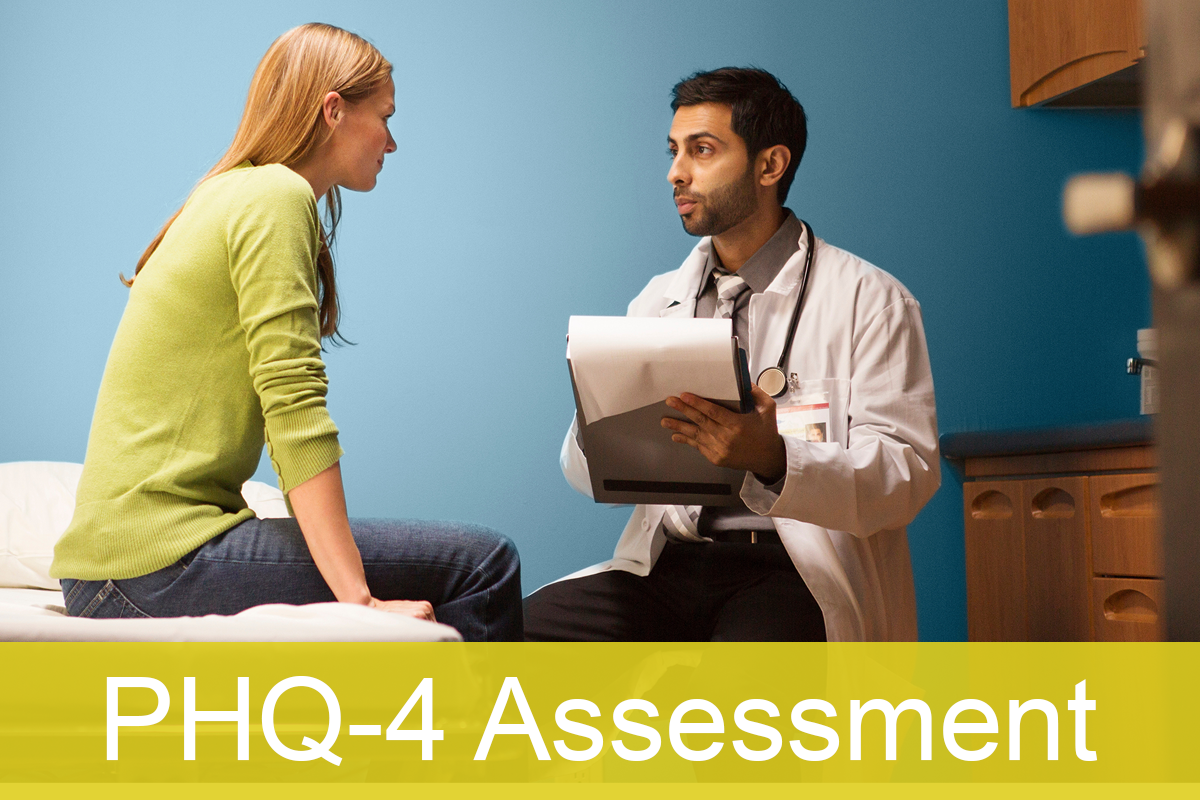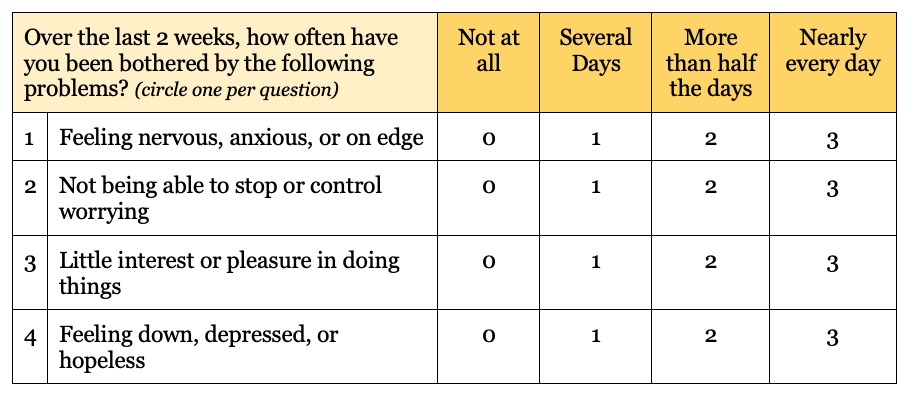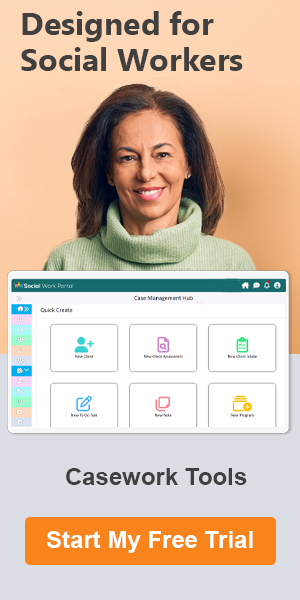Top 2024 Job Aid | What Is the PHQ 4 Questionnaire for Depression & Anxiety?
Best 2024 Guide | Overview of the PHQ4 Test & PHQ-4 Scoring
Mental health issues, such as depression and anxiety, have exploded over the past decade due to factors such as the increased use of social media and devices, and the COVID-19 pandemic.
The World Health Organization (WHO) estimates that 1 in 8 people globally lives with a mental health condition. And unfortunately, many of these conditions go undiagnosed because of a lack of screening in primary care settings.
The PHQ-4 is a screening tool that does a rapid screening for both depression and generalized anxiety. The brevity of the assessment makes it perfect to use in all types of environments for quick routine screenings for these two prevalent mental health disorders.

Patient Health Questionnaire 4 PHQ-4
If you’re looking for All-in-One Client and Case Management Software that comes equipped with a wide range of assessments, join All-in-One Case Management Hub Platform and embrace a digital solution that saves you time, enhances collaboration, and ensures the security and privacy of client information.
Where does the PHQ 4 test come from? Does the PHQ 4 depression screening tool test for anxiety too? We’ll answer those and other questions in this overview of the Patient Health Questionnaire-4.
See Also: CPT Codes for Mental Health & Therapy
Table of Contents: PHQ4 Depression & Anxiety Screening
Keep on scrolling down this page to read each section or click any link below to go directly to that section.
- What Does the Patient Health Questionnaire 4 Measure?
- Where Did the PHQ4 Originate?
- PHQ 4 Screening Questions
- How Do You Calculate the PHQ 4 Score?
- Conclusion | PHQ-4 Questionnaire
- FAQ | Patient Health Questionnaire 4 PHQ 4
Don’t Miss: Depression and Anxiety Questionnaire (PHQ & GAD Assessments)
What Does the Patient Health Questionnaire 4 Measure?
The PHQ 4 assessment measures indicators for both anxiety and depression. These two conditions are closely related, and it’s not unusual for a person to suffer from both.
The PHQ4 screening tool is one of the few designed to rapidly screen for both anxiety and depression, which makes it very useful in time-sensitive environments (busy doctors’ offices, health clinics, emergency rooms, etc.). It enables clinicians to do these routine screenings without taking up a lot of their or the individual’s time.
With SWP’s Client & Case Management Hub Platform, you can effortlessly incorporate assessments, intakes, letters, and case notes into your client management process.
Subscribe to Case Management Hub Software and experience the convenience of our intuitive interface, customizable templates, and efficient documentation features. Our platform empowers you to create, track, and manage client records with ease.
Related: What Types of Depression Screening Questionnaires Are the Most Popular with Health Practitioners?
Do you have any questions about PHQ-4 scoring or PHQ 4 PDF downloads? If so, contact the Social Work Portal Team.
Where Did the PHQ4 Originate?
The PHQ 4 test was developed by Drs. Spitzer, Williams, Kroenke, et al, with an educational grant from Pfizer. This four-question test for anxiety and depression was derived from combining the first two questions of the PHQ-9 and GAD-7 assessments.
The PHQ-9 is a nine-item questionnaire that detects depression and the severity of the depression.
The GAD-7 is a seven-item questionnaire that detects generalized anxiety disorder and the severity of the anxiety.
You can find both PHQ-9 and GAD-7 in our All-in-One Case Management solution. Sign up for Client & Case Management Software and simplify your intake and assessment process today.
These first two assessments were published in 1999, and in 2009, the PHQ4 assessment was published as an ultra-brief screening scale for depression and anxiety.
Popular Article: List of Anxiety Screeners & Depression Tools
PHQ 4 Screening Questions
As mentioned, rather than testing only for depression or anxiety, the PHQ 4 form screens for both. It has four screening questions, the first two address symptoms of anxiety, and the other two address symptoms of depression.
In many cases, the test and PHQ-4 scoring can be done in just 1-2 minutes. Each of the questions has four options for the frequency that someone has experienced the stated symptoms.
The PHQ 4 form asks the respondent to indicate how often they’ve experienced the issue “over the last 2 weeks.” The options and their PHQ-4 score are:
- Not at all (0)
- Several days (1)
- More than half the days (2)
- Nearly every day (3)
The questions/symptoms are as follows.

Read More: What You Need to Know about The GAD 7 Anxiety Test
Do you have any questions about the PHQ 4 assessment, PHQ 4 score, or PHQ 4 PDF downloads? If so, contact the Social Work Portal Team.
How Do You Calculate the PHQ 4 Score?
Since the Patient Health Questionnaire-4 screens for both depression and anxiety, scoring is looked at in both of those subsets.
- Subset A (Anxiety): Questions 1 & 2, which have a total PHQ 4 score range of 0 to 6.
- Subset B (Depression): Questions 3 & 4, which have a total PHQ 4 score range of 0 to 6.
For either subset, the cutoff point PHQ4 scoring is 3. So, if the individual scores 3 or more on Subset A, that indicates the potential for anxiety disorder. The recommended next step is to administer the longer GAD-7 test for anxiety to determine the severity.
For Subset B, a score of 3 or more will indicate the potential for depression. The recommended next step is to administer the PHQ-9 nine-question assessment for depression to identify the severity.
If you want to streamline your workflow and improve the way you conduct intakes, assessments, case notes, and so much more, make sure to subscribe to our All-in-One Client and Case Management Portal.
Related: General Anxiety Disorder-2 Questionnaire
Do you have any questions about the PHQ 4 depression screening tool or how to score the PHQ4 questionnaire? Click here to contact the Social Work Portal Team.
Conclusion | PHQ-4 Questionnaire
The Patient Health Questionnaire 4 is a reliable rapid screener that can flag symptoms of both anxiety and depression. Since both disorders often co-exist, the PHQ4 questionnaire can help clinicians catch these occurrences, as well as identify one or the other in a single survey.
Like the other GAD and PHQ assessments, the PHQ 4 scoring is quick, clear, and easy. The assessment can also be self-administered to save even more time.
To save yourself even more time, don’t miss this opportunity to sign up for Case Management Hub Software and take your practice to a whole new level.
While the PHQ4 assessment shouldn’t be used to give a diagnosis, it’s an excellent first step as an ultra-brief screening tool to see if a more extensive assessment should be done for depression and/or anxiety.
Don’t Miss: Overview of the PHQ-2 Questionnaire and PHQ 2 Test Screening
FAQ | Patient Health Questionnaire 4 PHQ 4
What does the Patient Health Questionnaire 4 measure?
The PHQ 4 assessment measures indicators for both anxiety and depression. These two conditions are closely related, and it’s not unusual for a person to suffer from both.
What does a PHQ score of 4 mean?
The PHQ4 score is looked at in two subsections. The first two questions make up the subsection for anxiety and the other two questions make up the subsection for depression. Three is the cutoff point for the PHQ 4 questionnaire for each subsection.
If the total of questions 1 & 2 equals 3 or higher, anxiety is indicated. If the total of questions 3 & 4 equals 3 or higher, depression is indicated.
Is there a PHQ for anxiety?
The PHQ-2 and PHQ-9 are both assessments for depression. The PHQ-4 test screens for both depression and anxiety.
How is the PHQ4 score calculated?
If the total of questions 1 & 2 equals 3 or higher, anxiety is indicated.
If the total of questions 3 & 4 equals 3 or higher, depression is indicated.
Note: Content on Social Works socialworkportal.com website is copyrighted.
Social Work Portal Disclaimer:Social Work Portal is not a social work agency and we do not refer social workers. This web site is provided for educational and informational purposes only and does not constitute providing medical advice or professional services. The information provided should not be used for diagnosing or treating a health problem or disease, and those seeking personal medical advice should consult with ... Read our full disclaimer here: Social Work Portal Disclaimer.
Image sources: Stock.adobe.com










